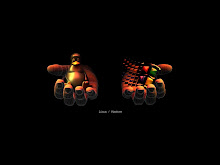sources: that is, devices such as tape decks, AM/FM receivers, phono players,
CD units, DVD players, and other consumer electronics devices that provide
the inputs of the content you listen to and watch through your entertainment
system.
When you think about adding your networked PC or PCs to your entertainment
mix, the PC becomes just another high-quality source device attached
to your A/V system — albeit wirelessly. To connect your PC to your entertainment
system, you must have some special audio/video cards and corresponding
software to enable your PC to “speak stereo.” When the PC is configured
like this, you effectively have a home theater PC (or HTPC, as the cool kids
refer to them). In fact, if you do it right, you can create an HTPC that funnels
audio and video into your system at a higher-quality level than many moderately
priced, stand-alone source components. HTPC can be that good.
You can either buy a ready-to-go HTPC right off the shelf or build one yourself.
We don’t recommend that you build an HTPC unless you have a fair amount
of knowledge about PCs. If that’s the case, have at it. Another obvious point:
It’s much easier to buy a ready-to-go version of an HTPC off the shelf.
What you expect from your home theater PC is quite different from what
David Bowie might expect from his HTPC. Regardless of your needs, however,
a home theater PC should be able to store music and video files, play CDs
and DVDs, let you play video games on the big screen, and tune in to online
music and video content. Thus, it needs ample hard drive space and the
appropriate software (see the following section). Also, your HTPC acts as a
DVR (see the nearby sidebar, “Checking out PC DVRs,” for the lowdown on
PC-based DVRs). In addition, an HTPC can
Store audio (music) files: Now you can easily play your MP3s anywhere
on your wireless network.
Store video clips: Keeping your digital home video tapes handy is quite
the crowd pleaser — you can have your own America’s Funniest Home
Videos show.
Play CDs and DVDs: The ability to play DVDs is essential in a home
theater environment.
Act as a DVR (digital video recorder): This optional (but almost essential,
we think) function uses the HTPC’s hard drive to record television
shows like a TiVo (www.tivo.com).
Let you play video games on the big screen: With the right hardware,
PCs are sometimes even better than gaming consoles (which we cover
in Chapter 11).
Tune in to online music and video content: Grab the good stuff off the
Internet (yes, and pay for it), and then enjoy it on the big screen with
good audio equipment.
Provide a high-quality, progressive video signal to your TV video display:
This is behind-the-curtain stuff. Simply, an HTPC uses special hardware
to display your PC’s video content on a TV. Sure, PCs have built-in
video systems, but most are designed to be displayed only on PC monitors,
not on TVs. To get the highest possible video quality on your bigscreen
HDTV, you need a special video card that can produce a highdefinition,
progressive-scan video signal. (This investment also gives
you better performance on your PC’s monitor, which is never bad.)
Decode and send HDTV content to your high-definition TV display:
HTPCs can provide a cheap way to decode over-the-air HDTV signals
and send them to your home entertainment center’s display. You just
need the right hardware (an HDTV-capable video card and a TV tuner
card). If you have HDTV, this is a cool optional feature of HTPC.
For example, the HP z560 Digital Entertainment Center (www.hp.com, $1,799)
is a full-fledged digital media center PC with onboard 802.11g functionality
and includes Microsoft’s Windows XP Media Center Edition or Windows Vista
Suscribirse a:
Enviar comentarios (Atom)











No hay comentarios:
Publicar un comentario